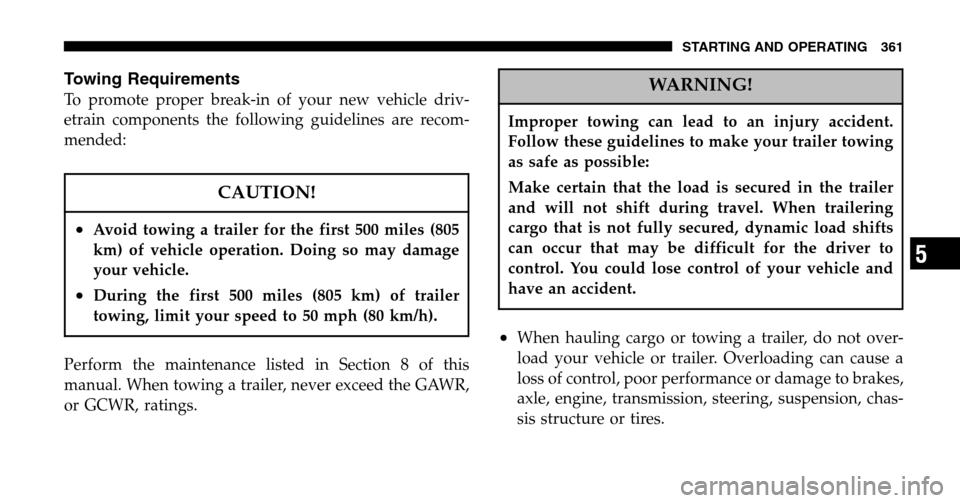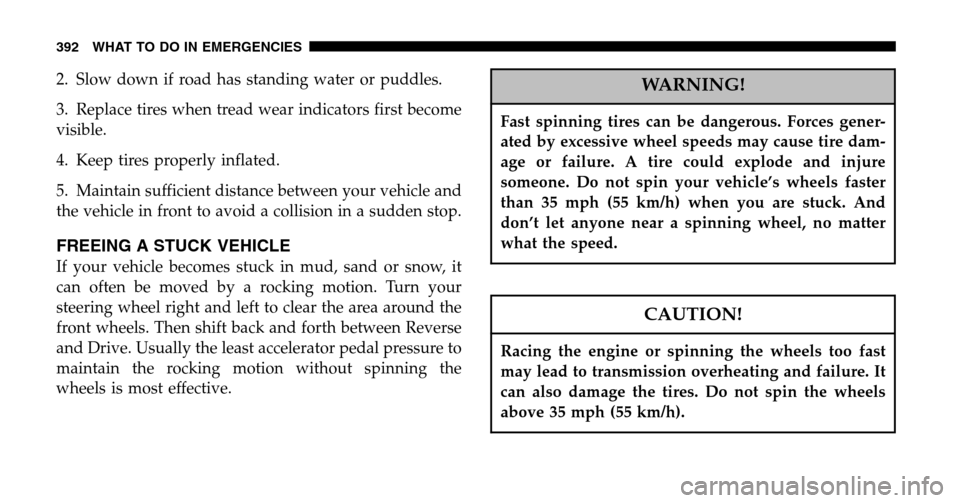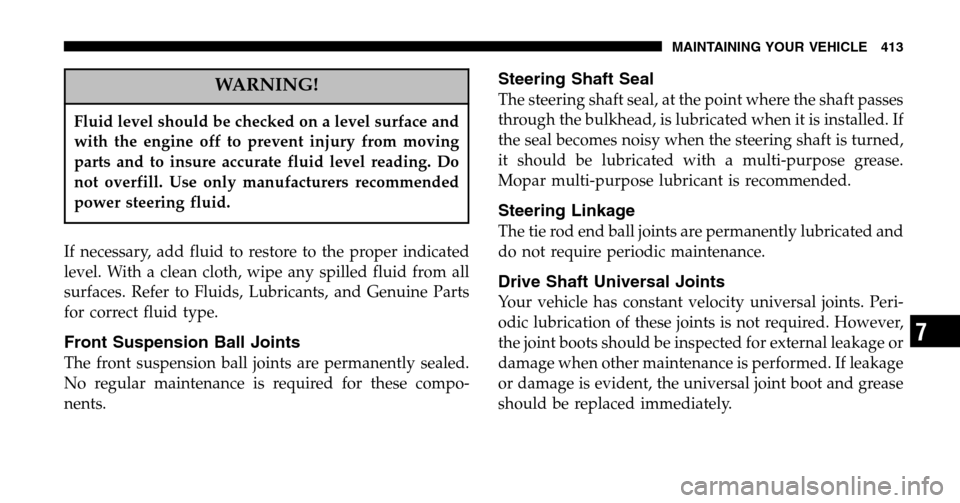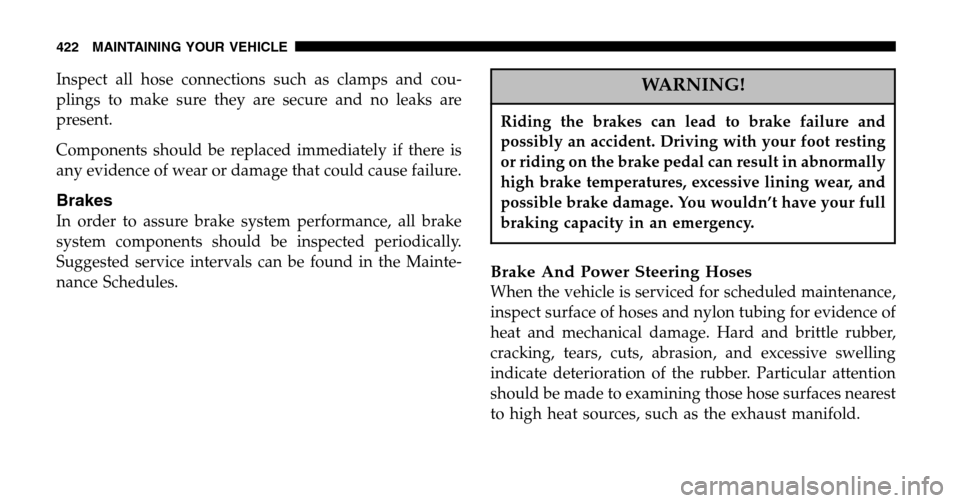Page 361 of 496

Towing Requirements
To promote proper break-in of your new vehicle driv-
etrain components the following guidelines are recom-
mended:
CAUTION!
•Avoid towing a trailer for the first 500 miles (805
km) of vehicle operation. Doing so may damage
your vehicle.
•During the first 500 miles (805 km) of trailer
towing, limit your speed to 50 mph (80 km/h).
Perform the maintenance listed in Section 8 of this
manual. When towing a trailer, never exceed the GAWR,
or GCWR, ratings.
WARNING!
Improper towing can lead to an injury accident.
Follow these guidelines to make your trailer towing
as safe as possible:
Make certain that the load is secured in the trailer
and will not shift during travel. When trailering
cargo that is not fully secured, dynamic load shifts
can occur that may be difficult for the driver to
control. You could lose control of your vehicle and
have an accident.
•When hauling cargo or towing a trailer, do not over-
load your vehicle or trailer. Overloading can cause a
loss of control, poor performance or damage to brakes,
axle, engine, transmission, steering, suspension, chas-
sis structure or tires.
STARTING AND OPERATING 361
5
Page 392 of 496

2. Slow down if road has standing water or puddles.
3. Replace tires when tread wear indicators first become
visible.
4. Keep tires properly inflated.
5. Maintain sufficient distance between your vehicle and
the vehicle in front to avoid a collision in a sudden stop.
FREEING A STUCK VEHICLE
If your vehicle becomes stuck in mud, sand or snow, it
can often be moved by a rocking motion. Turn your
steering wheel right and left to clear the area around the
front wheels. Then shift back and forth between Reverse
and Drive. Usually the least accelerator pedal pressure to
maintain the rocking motion without spinning the
wheels is most effective.
WARNING!
Fast spinning tires can be dangerous. Forces gener-
ated by excessive wheel speeds may cause tire dam-
age or failure. A tire could explode and injure
someone. Do not spin your vehicle’s wheels faster
than 35 mph (55 km/h) when you are stuck. And
don’t let anyone near a spinning wheel, no matter
what the speed.
CAUTION!
Racing the engine or spinning the wheels too fast
may lead to transmission overheating and failure. It
can also damage the tires. Do not spin the wheels
above 35 mph (55 km/h).
392 WHAT TO DO IN EMERGENCIES
Page 393 of 496

TOWING A DISABLED VEHICLE
With Ignition Key
Your vehicle may be towed under the following condi-
tions: The gear selector must be in NEUTRAL, the
distance to be traveled must not exceed 100 miles (160
km), and the towing speed must not exceed 44 mph (72
km/h). Exceeding these towing limits may cause a trans-
mission geartrain failure. If the transmission is not op-
erative, or if the vehicle is to be towed more than 100
miles (160 km), the vehicle must be towed with the front
wheels off the ground.
CAUTION!
•Do not attempt to tow this vehicle from the front
with sling type towing equipment. Damage to the
front fascia will result.
•Always use wheel lift equipment when towing
from the front. The only other approved method
of towing is with a flat bed truck.
•Do not tow the vehicle from the rear. Damage to
the rear sheet metal, liftgate and fascia will occur.
•Do not push or tow this vehicle with another
vehicle as damage to the bumper fascia and trans-
mission may result.
•If the vehicle being towed requires steering, the
ignition switch must be in the OFF position, not
in the LOCK or ACCESSORY positions.
WHAT TO DO IN EMERGENCIES 393
6
Page 395 of 496
MAINTAINING YOUR VEHICLE
CONTENTS
�3.3L/3.8L Engines ......................398
� Onboard Diagnostic System — OBD II ........399
� Emissions Inspection And Maintenance
Programs ............................400
� Replacement Parts ......................401
� Dealer Service .........................401
� Maintenance Procedures ..................402
▫ Engine Oil ..........................402
▫ Engine Oil Filter ......................406 ▫
Drive Belts — Check Condition And Tension . . 406
▫ Spark Plugs .........................407
▫ Engine Air Cleaner Filter ................407
▫ Catalytic Converter ....................407
▫ Maintenance-Free Battery ................409
▫ Air Conditioner Maintenance .............411
▫ Power Steering — Fluid Check ............412
▫ Front Suspension Ball Joints ..............413
▫ Steering Shaft Seal ....................413
7
Page 396 of 496

▫Steering Linkage ......................413
▫ Drive Shaft Universal Joints ..............413
▫ Body Lubrication .....................414
▫ Windshield Wiper Blades ................414
▫ Windshield And Rear Window Washers .....415
▫ Exhaust System ......................415
▫ Cooling System .......................416
▫ Hoses And Vacuum/Vapor Harnesses .......421
▫ Brakes .............................422
▫ Master Cylinder — Brake Fluid Level Check . . 423
▫ Fuel System Hoses ....................425
▫ Automatic Transmission ................425
▫ Front And Rear Wheel Bearings ...........428 ▫
Appearance Care And Protection From
Corrosion ...........................428
▫ Cleaning The Instrument Panel And Underseat
Cup Holders ........................433
� Integrated Power Module (IPM) ............434
� Vehicle Storage ........................437
� Replacement Light Bulbs .................438
� Bulb Replacement ......................439
▫ Headlights ..........................439
▫ Front Park/Turn Signal And Sidemarker
Lights .............................440
▫ Front Fog Light ......................441
▫ Rear Tail, Stop, Turn Signal, Side Marker And
Back-Up Lights .......................442
396 MAINTAINING YOUR VEHICLE
Page 412 of 496

Refrigerant Recovery And Recycling
R-134a Air Conditioning Refrigerant is a hydrofluorocar-
bon (HFC) that is endorsed by the Environmental Pro-
tection Agency and is an ozone-saving product. How-
ever, the manufacturer recommends that air conditioning
service be performed by dealers or other service facilities
using recovery and recycling equipment.
NOTE: Use only manufacturer approved A/C System
Sealers, Stop Leak Products, Seal Conditioners, Compres-
sor Oil, or Refrigerants.
A/C Air Filter — If Equipped
The A/C Filter, if so equipped, is found behind the filter
access door located under the instrument panel on the
passenger side. To replace the filter slide the lock toward
the rear of the vehicle (unlock position). Remove the
access door and pull the filter downward. When install-
ing a new filter, ensure its proper orientation. Align the black arrow on the bottom of the filter frame with the
direction of airflow (away from the blower motor and
towards the center of the car).
Refer to the “Maintenance Schedules” section of this
manual for the recommended air conditioning filter
replacement intervals.
Power Steering — Fluid Check
Checking the power steering fluid level at a defined
service interval is not required. The fluid should only be
checked if a leak is suspected, abnormal noises are
apparent, and/or the system is not functioning as antici-
pated. Coordinate inspection efforts through a certified
DaimlerChrysler Dealership.
�
412 MAINTAINING YOUR VEHICLE
Page 413 of 496

WARNING!
Fluid level should be checked on a level surface and
with the engine off to prevent injury from moving
parts and to insure accurate fluid level reading. Do
not overfill. Use only manufacturers recommended
power steering fluid.
If necessary, add fluid to restore to the proper indicated
level. With a clean cloth, wipe any spilled fluid from all
surfaces. Refer to Fluids, Lubricants, and Genuine Parts
for correct fluid type.
Front Suspension Ball Joints
The front suspension ball joints are permanently sealed.
No regular maintenance is required for these compo-
nents.
Steering Shaft Seal
The steering shaft seal, at the point where the shaft passes
through the bulkhead, is lubricated when it is installed. If
the seal becomes noisy when the steering shaft is turned,
it should be lubricated with a multi-purpose grease.
Mopar multi-purpose lubricant is recommended.
Steering Linkage
The tie rod end ball joints are permanently lubricated and
do not require periodic maintenance.
Drive Shaft Universal Joints
Your vehicle has constant velocity universal joints. Peri-
odic lubrication of these joints is not required. However,
the joint boots should be inspected for external leakage or
damage when other maintenance is performed. If leakage
or damage is evident, the universal joint boot and grease
should be replaced immediately.
MAINTAINING YOUR VEHICLE 413
7
Page 422 of 496

Inspect all hose connections such as clamps and cou-
plings to make sure they are secure and no leaks are
present.
Components should be replaced immediately if there is
any evidence of wear or damage that could cause failure.
Brakes
In order to assure brake system performance, all brake
system components should be inspected periodically.
Suggested service intervals can be found in the Mainte-
nance Schedules.
WARNING!
Riding the brakes can lead to brake failure and
possibly an accident. Driving with your foot resting
or riding on the brake pedal can result in abnormally
high brake temperatures, excessive lining wear, and
possible brake damage. You wouldn’t have your full
braking capacity in an emergency.
Brake And Power Steering Hoses
When the vehicle is serviced for scheduled maintenance,
inspect surface of hoses and nylon tubing for evidence of
heat and mechanical damage. Hard and brittle rubber,
cracking, tears, cuts, abrasion, and excessive swelling
indicate deterioration of the rubber. Particular attention
should be made to examining those hose surfaces nearest
to high heat sources, such as the exhaust manifold.
422 MAINTAINING YOUR VEHICLE